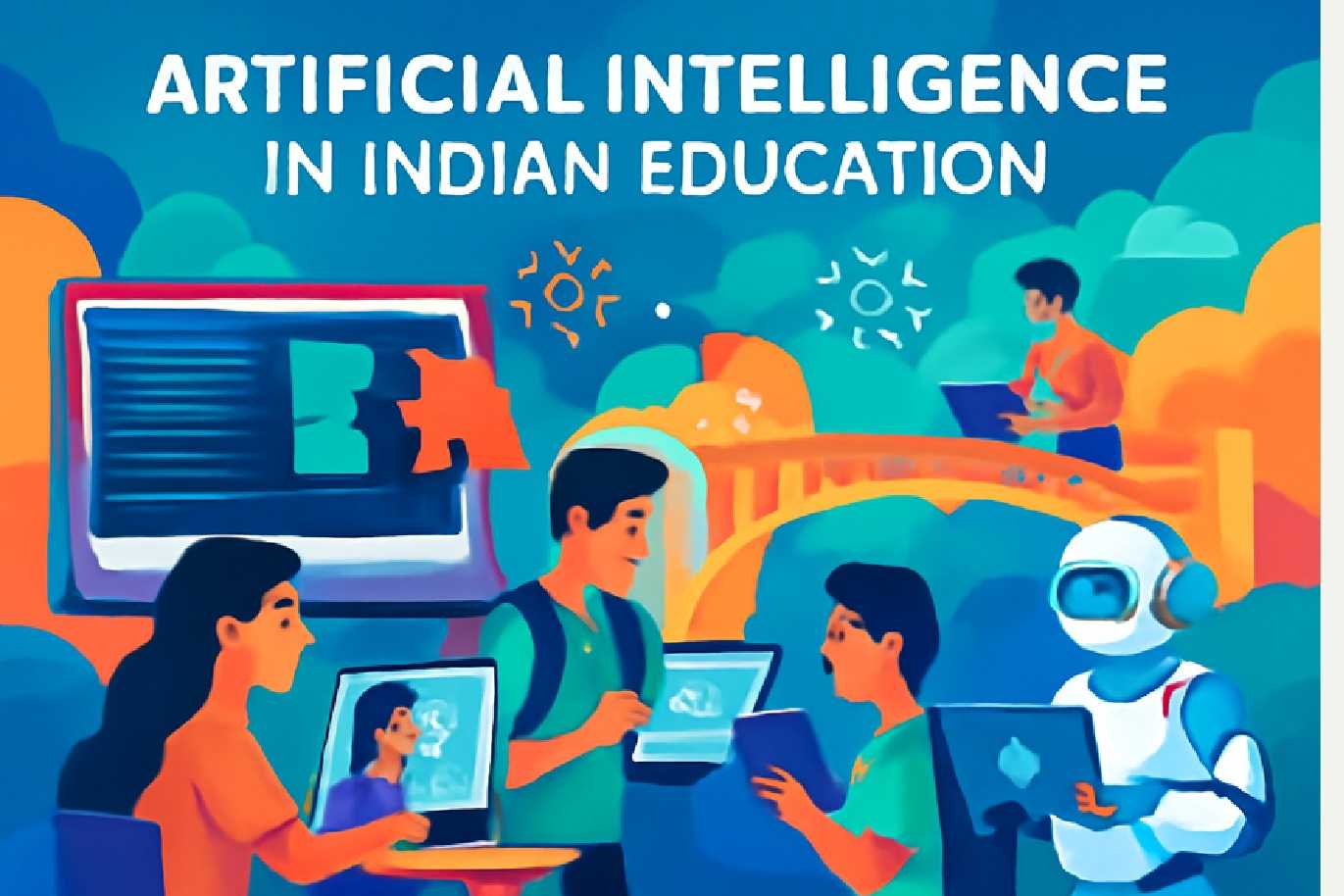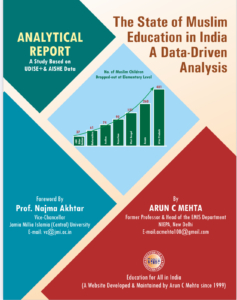
Role of Artificial Intelligence in Indian Education: Bridging Gaps and Shaping Futures
Role of Artificial Intelligence in Indian Education: Bridging Gaps and Shaping Futures
Introduction
Artificial Intelligence (AI) is reshaping industries globally, and education in India is no exception. With a constitutional commitment to free and compulsory education for children aged 6-14 under the Right to Education Act (2009), India has made significant strides toward universal schooling. However, challenges like high dropout rates, infrastructure deficits, and the digital divide persist, particularly in rural and marginalized communities. AI offers innovative solutions to these issues, enhancing learning outcomes, streamlining administration, and fostering equity in both school (K-12) and higher education. This article explores the transformative potential of AI in Indian education, its necessity, supporting data, recent initiatives, and alignment with the National Education Policy (NEP) 2020, drawing on insights from UDISE+ data and Samagra Shiksha trends.
The Need for AI in Indian Education
India’s education system faces multifaceted challenges: large class sizes, teacher shortages, outdated curricula, and unequal access to quality education, particularly in rural areas and among marginalized groups. According to UDISE+ 2023-24 data, total school enrollment dropped by 8.12% from 255.74 million in 2021-22 to 234.96 million in 2023-24, with significant declines at the primary (11.49%) and secondary levels (14.1% dropout rate) . These trends underscore the urgency of innovative interventions like AI to address:
- Personalized Learning: AI-driven platforms analyse student data to deliver tailored content, addressing diverse learning needs, including those of students with disabilities or language barriers.
- Administrative Efficiency: AI automates grading, scheduling, and data management, reducing teacher workload and improving institutional efficiency.
- Bridging the Digital Divide: AI-powered offline tools and low-bandwidth apps can deliver education to remote areas with limited internet access.
- Skill Development: AI equips students with digital literacy and critical thinking skills essential for 21st-century careers, aligning with NEP 2020’s emphasis on vocational training.
- Support for Marginalized Populations: AI offers multilingual instruction and assistive technologies to include Scheduled Castes (SC), Scheduled Tribes (ST), and minority students.
Without AI, achieving NEP 2020’s goal of universal school education by 2030 remains challenging, particularly for the 47.4 million out-of-school children (OOSC) reported in 2023-24 .
Elaborating the Use of AI in Education
AI’s applications in education extend beyond personalization and administration, offering transformative tools to enhance teaching and learning:
-
-
- Intelligent Tutoring Systems (ITS): Platforms like BYJU’S and Khan Academy use AI to provide interactive, adaptive tutoring, adjusting content difficulty based on student performance. These systems are particularly effective in STEM subjects, where students often need additional support.
- Predictive Analytics: AI identifies at-risk students by analysing attendance, grades, and behavioural data, enabling early interventions to reduce dropout rates. For instance, UNICEF India’s AI-based early warning systems predict dropout risks, crucial for addressing the 14.1% secondary-level dropout rate in 2023-24 .
- Virtual Classrooms and AR/VR: AI-powered augmented reality (AR) and virtual reality (VR) create immersive learning experiences, simulating labs or historical events, particularly beneficial for higher education and vocational training.
- Language Processing Tools: AI-driven translation and speech recognition tools support India’s linguistic diversity, enabling mother-tongue instruction as emphasized by NEP 2020.
-
- AI-Driven Data Management: AI optimizes platforms like UDISE+ and SDMS for real-time data analysis, improving resource allocation and policy planning under Samagra Shiksha .
- Teacher Support Tools: AI chatbots assist teachers with lesson planning, while AI-driven professional development platforms offer personalized training, addressing the 24% teacher shortage at the primary level .
- These applications enhance access, engagement, and efficiency, making AI indispensable for scaling education in a diverse and populous country like India.
-
Review of Literature
Research on AI in education (AIED) highlights its potential and challenges. A 2021 study in the International Journal of Artificial Intelligence in Education notes that while over 30 countries had AI policy strategies by 2021, AIED was often side-lined, with a focus on workforce readiness rather than educational transformation . A 2023 World Economic Forum report emphasizes AI’s role in supporting marginalized communities through initiatives like UNICEF’s Gateways to Public Digital Learning, which pilots AI solutions in Africa, Asia, and Latin America .
A 2024 PNAS Nexus study warns that without inclusive policies, AI could widen socioeconomic gaps, as high-income settings dominate AI development . In India, Prof. Arun C. Mehta’s analysis of UDISE+ data underscores the need for AI to address high dropout rates (14.1% at the secondary level in 2023-24) and the 47.4 million OOSC, particularly among SC, ST, and Muslim students . A 2025 Smart Learning Environments study cautions against over-reliance on AI dialogue systems, which may reduce critical thinking in higher education .
Supporting Data and Charts
UDISE+ data reveals critical trends in Indian education, highlighting the need for AI interventions:
-
- Enrollment Decline: Total enrollment dropped from 255.74 million in 2021-22 to 234.96 million in 2023-24, a reduction of 20.8 million students (8.12%) .
- Gross Enrollment Ratio (GER): Primary GER remained near universal at 93% in 2022-23, but secondary (77.4%) and higher secondary (56.2%) GERs lag, indicating retention challenges .
- Dropout Rates: Primary dropout rates spiked to 7.8% in 2022-23 but fell to 1.9% in 2023-24; secondary dropout rates remained high at 14.1% in 2023-24 .
- Digital Divide: Only 57.7% of schools had computers, and 53.9% had internet connectivity in 2023-24, with rural schools lagging at 30% internet access .
- Dropout Rates at Secondary Level (2020-21 to 2023-24)
Analysis
The UDISE+ data highlights a persistent decline in enrollment, particularly at the secondary level, where the 14.1% dropout rate in 2023-24 signals systemic issues like economic pressures and inadequate infrastructure . AI can address these by enabling predictive analytics to retain at-risk students and delivering digital content to rural areas. However, the digital divide – evident in only 30% of rural schools having internet access—limits AI’s reach .
In higher education, AI-driven platforms like Coursera and up-grad offer flexible learning, but access remains skewed toward urban, affluent students. Ethical concerns, such as algorithmic bias and data privacy, require robust guidelines, as AI systems trained on biased data (e.g., urban-centric datasets) may marginalize rural and minority students further.
Recent Initiatives and Government Policies
India has launched several AI-driven initiatives under Samagra Shiksha and NEP 2020:
-
- PM eVidya: Provides digital classrooms and AI-based learning apps like DIKSHA, reaching rural students .
- UNICEF India: Developing AI early warning systems to reduce dropouts among marginalized groups.
- SDMS-UDISE+: AI optimizes data management for better resource allocation .
- PM JANMAN: Sanctions hostels for 85,250 PVTG students, supported by AI-driven enrollment tracking .
Globally, countries like China, Singapore, and the U.S. have integrated AI into education, with China’s AI tutoring systems and Singapore’s Smart Nation initiative leading the way. India’s policies must focus on infrastructure, teacher training, and ethical AI use to match these benchmarks.
Concluding Observations
AI is a powerful tool for transforming Indian education, offering personalized learning, administrative efficiency, and equitable access. However, its success depends on addressing the digital divide, ensuring ethical implementation, and investing in infrastructure. With 47.4 million OOSC and high secondary dropout rates, AI-driven interventions are critical to achieving NEP 2020’s universal education goal by 2030. Stakeholders must prioritize:
- Infrastructure Investment: Expand internet and device access in rural areas.
- Teacher Training: Equip educators with AI literacy.
- Ethical Guidelines: Mitigate bias and protect student data.
- Inclusive Policies: Target SC, ST, and minority communities.
By leveraging AI strategically, India can bridge educational gaps and prepare students for a digital future, ensuring no child is left behind.
Suggested Readings
-
- Mehta, A. C. (2023). School Education in India: Where Do We Stand? UDISEPlus 2023-24. Education for All in India
- Mehta, A. C. (2023). Out-of-School Children (OOSC) in the Light of UDISEPlus 2023-24 Data. Education for All in India
- Mehta, A. C. (2023). UDISEPlus 2023-24 Frequently Asked Questions. Education for All in India
- Mehta, A. C. (2023). AI-Driven Educational Data Management in India. Education for All in India
- Mehta, A. C. (2023). Five Years of NEP 2020: Achievements and Missed Opportunities. Education for All in India
- Education for AI, not AI for Education. International Journal of Artificial Intelligence in Education. Springer
- Can AI Transform Learning for Marginalized Communities? World Economic Forum. WEF
- Impact of Generative AI on Socioeconomic Inequalities. PNAS Nexus. OUP
- Effects of Over-Reliance on AI Dialogue Systems. Smart Learning Environments. Springer


